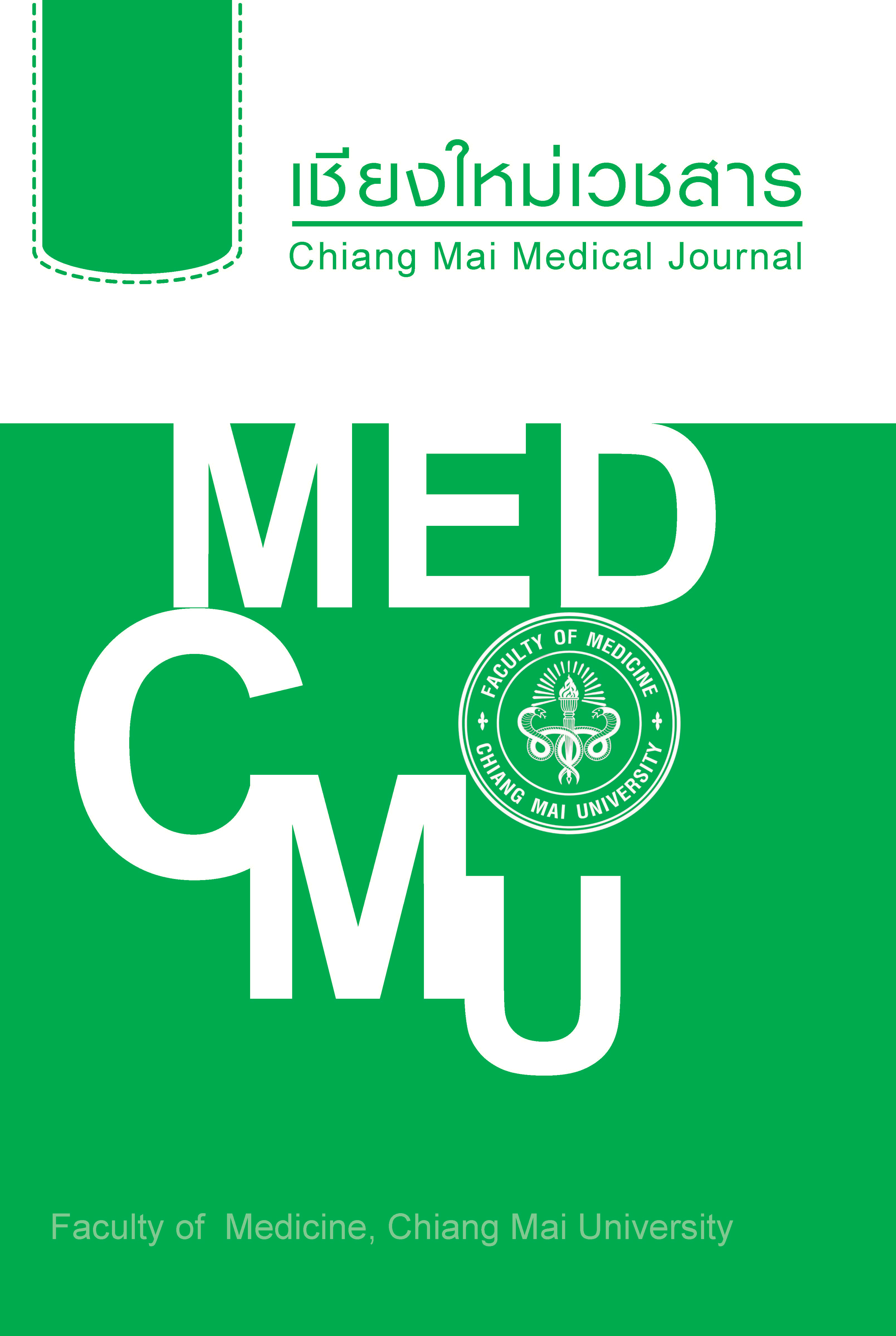Exercise and quality of life in medical students
Keywords:
exercise, quality of life, SF-36, medical studentAbstract
Objective To determine the prevalence of exercise among medical students and examine the association between exercise and quality of life (QOL).
Methods A retrospective cross-sectional study was conducted using secondary health data from 2nd to 5th year medical student at Chiang Mai University (class of 2016). Adequate exercise was defi ned as an average exercise of 3 days/week with ≥30 minutes/session. QOL was assessed using SF-36.
Results Of 933 medical students, 47.5% were male. Mean age was 21.5 years old. 29.3% had adequate exercise. There was no difference in levels of exercise among 2nd to 5th year. Male students were more likely to have adequate exercise than female (36.12% vs 23.06%, p <0.01). Medical students reported adequate exercise had better QOL compare to those who had inadequate exercise or no exercise (p <0.01).
Conclusion Exercise is correlated with better QOL in medical students. However, majority of students have inadequate exercise. Encouraging medical students into exercise may improve their QOL during medical school. Further study should emphasize on types of exercise and factors associated with adequate exercise.
References
2. Dyrbye LN, West CP, Satele D, Boone S, Tan L, Sloan J, et al. Burnout Among U. S. Medical Students, Residents, and Early Career Physicians Relative to the General U. S. Population. Acad Med. 2014;89:443-51.
3. วิทยา บุญเลิศเกิดไกร, ชาติชาย คล้ายสุบรรณ. ปัจจัยด้านความเครียดกับคุณภาพชีวิตของนิสิตแพทย์ ศูนย์แพทยศาสตร์ศึกษาชั้นคลินิก. บูรพาเวชสาร. 2558;1:4-14.
4. Angkurawaranon C, Jiraporncharoen W, Sachdev A, Wisetborisut A, Jangiam W, Uaphanthasath R. Predictors of quality of life of medical students and a comparison with quality of life of adult health care workers in Thailand. Springerplus. 2016;5:584.
5. Kunadison W, Pitanupong J. Mental health and associated factors in Prince of Songkla University medical student. Songkla Med. 2010;28:139-44.
6. Domantay JA. Health-Related Quality of Life of Future Physicians at a Medical School in the Philippines: A Cross-Sectional Study. SAGE Open. 2014;2:1-9.
7. Wen J, Cheng Y, Hu X, Yuan P, Hao T, Shi Y. Workload, burnout, and medical mistakes among physicians in China: A cross-sectional study. Biosci Trends. 2016;10:27-33.
8. Dyrbye LN, Satele D, Shanafelt TD. Healthy Exercise Habits Are Associated With Lower Risk of Burnout and Higher Quality of Life Among U.S. Medical Students. Acad Med. 2017;92:1006-11.
9. Joseph RP, Royse KE, Benitez TJ, Pekmezi DW. Physical activity and quality of life among university students: exploring self-efficacy, self-esteem, and affect as potential mediators. Qual Life Res. 2014;23:659-67.
10. Anokye NK, Trueman P, Green C, Pavey TG, Taylor RS. Physical activity and health related quality of life. BMC Public Health. 2012;12: 624.
11. Pucci CG, Rech CR, Fermino RC, Reis RS. Association between physical activity and quality of life in adults. Rev Saude Publica. 2012;46:166-79.
12. Balboa-Castillo T, Leon-Munoz LM, Graciani A, Rodriguez-Artalejo F, Guallar-Castillon P. Longitudinal association of physical activity and sedentary behavior during leisure time with health-related quality of life in community-dwelling older adults. Health Qual Life Outcome. 2011;9:47.
13. Narin J, Taravut T, Sangkoumnerd T, Thimachai P, Pakkaratho P, Kuhirunyaratn P, et al. Prevalence and Factors Associated with Sufficient Physical Activity Among Medical Students in Khon Kaen University. Srinagarind Med. 2008;23: 389-95.
14. office Ns. Survey on population behavior in playing sport or physical exercise and mental health 2011. Bangkok: Statistical Forecasting Bureau; 2012.
15. Higgins JW, Gaul C, Gibbons S, Van Gyn G. Factors influencing physical activity levels among Canadian youth. Can J Public Health. 2003;94:45-51.
16. Azevedo MR, Araujo CL, Reichert FF, Siqueira FV, da Silva MC, Hallal PC. Gender differences in leisure-time physical activity. Int J Public Health. 2007;52:8-15.
17. O’Donoghue G, Perchoux C, Mensah K, Lakerveld J, van der Ploeg H, Bernaards C, et al. A systematic review of correlates of sedentary behaviour in adults aged 18-65 years: a socio-ecological approach. BMC Public Health. 2016;16:163.
18. Chen LJ, Haase AM, Fox KR. Physical activity among adolescents in Taiwan. Asia Pac J Clin Nutr. 2007;16:354-61.
19. Feldman DE, Barnett T, Shrier I, Rossignol M, Abenhaim L. Is physical activity differentially associated with different types of sedentary pursuits? Arch Pediatr Adolesc Med. 2003;157:797-802.
20. Donaire-Gonzalez D, de Nazelle A, Cole-Hunter T, Curto A, Rodriguez DA, Mendez MA, et al. The Added Benefit of Bicycle Commuting on the Regular Amount of Physical Activity Performed. Am J Prev Med. 2015;49:842-9.
21. Gill DL, Hammond CC, Reifsteck EJ, Jehu CM, Williams RA, Adams MM, et al. Physical activity and quality of life. J Prev Med Public Health. 2013;46 Suppl 1:S28-34.
22. Galán I, Boix R, Medrano MJ, Ramos P, Rivera F, Pastor-Barriuso R, et al. Physical activity and self-reported health status among adolescents A cross-sectional population-based study. BMJ Open. 2013;3(5). pii: e002644. doi: 10.1136/bmjopen-2013-002644.
Downloads
Published
How to Cite
Issue
Section
License

This work is licensed under a Creative Commons Attribution-NonCommercial-NoDerivatives 4.0 International License.










